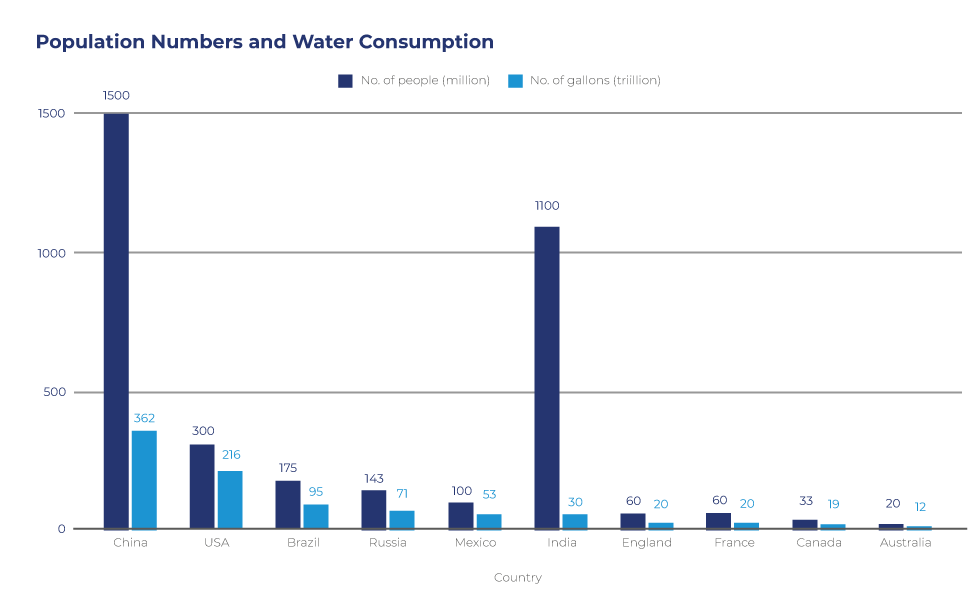We know that industrial water consumption places strain on the world’s limited water supply. In fact, the agricultural and industrial sectors account for approximately 90% of direct water withdrawals.
Why should we care?
The Water Resources Group, an arm of the World Bank, says that water demand is expected to exceed current supply by 40% by 2030 – just ten years away! Competition between communities and countries for scarce water resources is increasing, especially as climate change is exacerbating risk and unpredictability. Water scarcity is also caused by water resource mismanagement.
So which industries consume the most water?
#1 Fruit and Vegetable Farming
Although meat farming is often targeted as the most intensive sector for energy and carbon, it’s actually lower on the list compared to grain, fruit and vegetable farming.
Which are the thirstiest crops?
- Wheat
- Corn
- Rice
- Cotton
- Sugarcane
#2 Garments and Textiles
The garment and textile industry is one of the most water-intensive industries in the world. In fact, creating a single pair of jeans requires close to 7600 litres of water. Water is primarily used for the fabric dyeing process as well as “wet processing”.
#3 Meat Production
The industrial meat production complex uses a lot of water, almost a third of the water footprint of total agricultural production.
#4 Beverage Industry
The beverage sector produces juices, sodas, beers and a range of other drinks. Along with the water required in the liquids themselves, the additives add a water-intensive agricultural aspect (the industry requires farmed products such as barley, sugar, coffee, fruit etc.)
According to the Water Footprint Network, it takes:
- Between 680 and 1241 litres to produce a 2-litre bottle of soda
- 75 litres of water to make a pint of beer
- 140 litres of water to produce the ingredients to make a single cup of coffee
#5 Automotive Manufacturing
It takes a staggering 147631 litres to produce the average domestic vehicle. In the automotive industry, major water use occurs in:
- Surface treatment and coating
- Paint spray booths
- Washing/rinsing/hosing
- Cooling
- Air conditioning systems
- Boilers
How can industries reduce water consumption?
- Smart technology and irrigation management – including sensor technology and satellite imagery to identify where water is needed and where water is being wasted.
- Better supply chain procurement and management – such as choosing suppliers and farmers that use sustainable agricultural practices.
- Committing to clean and return water to the environment.
- Utilising natural ecosystems for water resource management.
How does England’s water consumption compare with the rest of the world?
According to National Water Footprint Accounts, these are the top 10 water using countries around the world:
- China: 1.5 billion people, 362 trillion gallons annually
- United States: 300 million people, 216 trillion gallons
- Brazil: 175 million people, 95 trillion gallons
- Russia: 143 million people, 71 trillion gallons
- Mexico: 100 million people, 53 trillion gallons
- India: 1.1 billion people, 30 trillion gallons
- England: 60 million people, 20 trillion gallons
- France: 60 million people, 20 trillion gallons
- Canada: 33 million people, 19 trillion gallons
- Australia: 20 million people, 12 trillion gallons

| Country | No. of people (million) | No. of gallons (trillion) |
| China | 1500 | 362 |
| USA | 300 | 216 |
| Brazil | 175 | 95 |
| Russia | 143 | 71 |
| Mexico | 100 | 53 |
| India | 1100 | 30 |
| England | 60 | 20 |
| France | 60 | 20 |
| Canada | 33 | 19 |
| Australia | 20 | 12 |
How your business can start saving water
Saving water starts by having an effective water management strategy in place. Many businesses choose to outsource to expert water consultants to identify and implement saving-saving efficiencies.
Our Smarter Business water team is on hand to get you started on your water-saving journey. We can also help you save on business water rates by walking you through the process of switching suppliers for a cheaper deal.
Get in touch today for a free consultation and whole-of-market water comparison.

